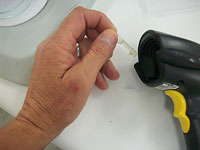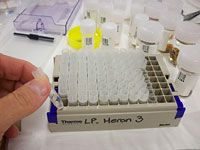

 | |||||||||
|
|
Journals 2008/2009Zamaria Rocio
August 30, 2008
Today in the lab Laetista showed me what to do with the invertebrates we got from the coral head the previous day. First, we divided them into groups: Polychaetes (worms), Echinoderms, Mollusks, Crustaceans, and others. She would then divide them farther as best as she could. Next we took tissue samples. I worked on the Polychaetes. Using 70% ethanol I cleaned the bottom of the glass petri dish I inverted. I was going to use this as my "cutting board." I placed one of the worms on the dish and cut a few millimeters of its tail off using a sterile scalpel. 
Then I placed this small piece into a tiny plastic vial containing a milliliter of 100% ethanol and closed the lid. On the bottom of each vial was a bar code that could be read by a scanner gun, which in turn was connected to a laptop computer. 
When the scanner read the bar code, it went onto a spreadsheet with other crucial information for each specimen. The information included where the coral head was found. The vial was placed in the matrix box with the other samples. 
All the filled vials were going to be sent to a laboratory for DNA analysis. This analysis sequences the DNA and can also determine if it is from a new species. The polychaete's end of the head on it was placed in a small plastic container with 70% ethanol. This part of the animal was being saved for identifying the specimen and was given to the scientists working on the polychaetes in our group. The scalpel and forceps I used were placed in a container of undiluted bleach to disinfect them. Next they went into a container of plain tap water and placed on paper towels to air dry. I would then repeat the whole process with another polychaete. As for taking a tissue sample from the crabs, I would remove one of their hind legs and put it into one of the vials for DNA analysis. The rest of the procedure was the same as the polychaetes. |
||||||||
